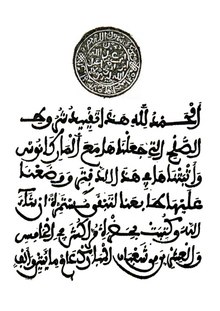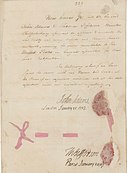Moroccan–American Treaty of Friendship
Moroccan–American Treaty of Friendship (Treaty of Marrakesh), 1786–1787 | |
| Signed | 28 June 1786, 15 July 1786 |
|---|---|
| Location | Marrakesh, Morocco |
| Original signatories | |
The Moroccan–American Treaty of Peace and Friendship, also known as the Treaty of Marrakesh,[1] was a bilateral agreement signed in 1786 that established diplomatic and commercial relations between the United States and Morocco.[2] It was the first treaty between the U.S. and an Arab, African, and Muslim nation, and initiated what as of 2024[update] remains the longest unbroken diplomatic relationship in U.S. history.[3]
Nearly a decade before the treaty, on 20 December 1777, Moroccan Sultan Mohammed III, decreed that American ships could freely enter his kingdom's ports and enjoy safe passage through its waters; and became one of the first heads of state to publicly recognize U.S. independence during the American Revolutionary War.[4][5]
Following several overtures by the Sultan, and with the urging of John Adams, John Jay, and Benjamin Franklin, in 1785 the U.S. Congress authorized negotiations for a treaty with Morocco. American diplomat Thomas Barclay was chosen to represent the U.S., and with the aid and backing of Spain, met his Moroccan counterpart, Tahir Fannish, in Marrakesh in June 1786. The treaty was finalized within days of Barclay's arrival, sealed by Mohammed III, and signed by Thomas Jefferson and John Adams at their respective diplomatic posts in Paris and London; Congress ratified the treaty on 18 July 1787, which was to last fifty years.[6][7]
Background

Muhammad III, or Sidi Muhammad bin Abdallah, came to power in 1757 and ruled until his death in 1790. Prior to his reign,
See also
- List of treaties
- Morocco–United States relations
- Moorish sovereign citizens
- American Legation, Tangier
References
- ^ History of the U.S. and Morocco - U.S. Embassy & Consulates in Morocco (usembassy.gov) " Also called the Treaty of Marrakech ..."
- ^ "History of the U.S. and Morocco". U.S. Embassy & Consulate in Morocco. Retrieved November 19, 2020.
- ^ a b Ogot, General History of Africa, pp. 231–232.
- JSTOR 3181936.
- ^ "History of the U.S. and Morocco". U.S. Embassy & Consulate in Morocco. Retrieved November 19, 2020.
- ISBN 978-0-934223-98-0.
- ^ "US-Morocco: Longstanding Ties (Remarks by President Bush and King Hassan II); U.S. Department of State Dispatch". January 24, 2007.
- ^ B.A. Ogot, General History of Africa, Vol. V: Africa from the 16th to the 18th Century. Berkeley: University of California Press, 1992. pp. 231–232.
- ^ Roberts, Thomas Barclay (1728–1793)..., pp. 195–223
External links
- English text of the treaty from Yale's Lillian Goldman Law Library
- The Moroccan-American Treaty of Peace and Friendship, [28 June 1786]", Founders Online, National Archives
- "Long-time friends: a history of early U.S.-Moroccan relations 1777-1787" by Sherrill B. Wells, Embassy of the United States, Rabat, Morocco
- "Historical Background on United States - Morocco Relations", Embassy of the United States, Rabat, Morocco
- "Morocco-US relations", Embassy of the Kingdom of Morocco
- "Moroccan–U.S. Relations, 1750–1912", Moroccan American Trade and Investment Council
![]() This article incorporates public domain material from websites or documents of the United States Department of State.
This article incorporates public domain material from websites or documents of the United States Department of State.


